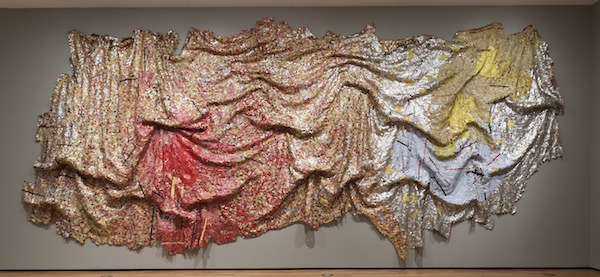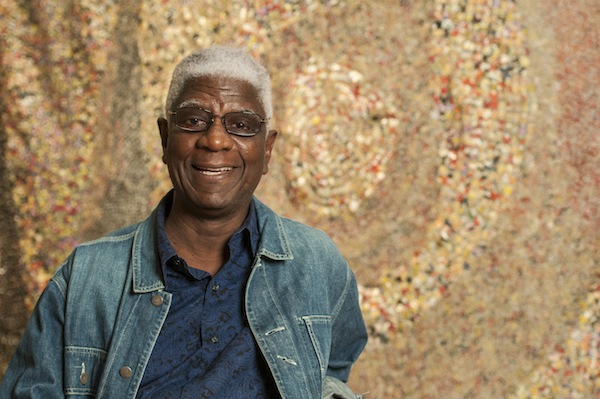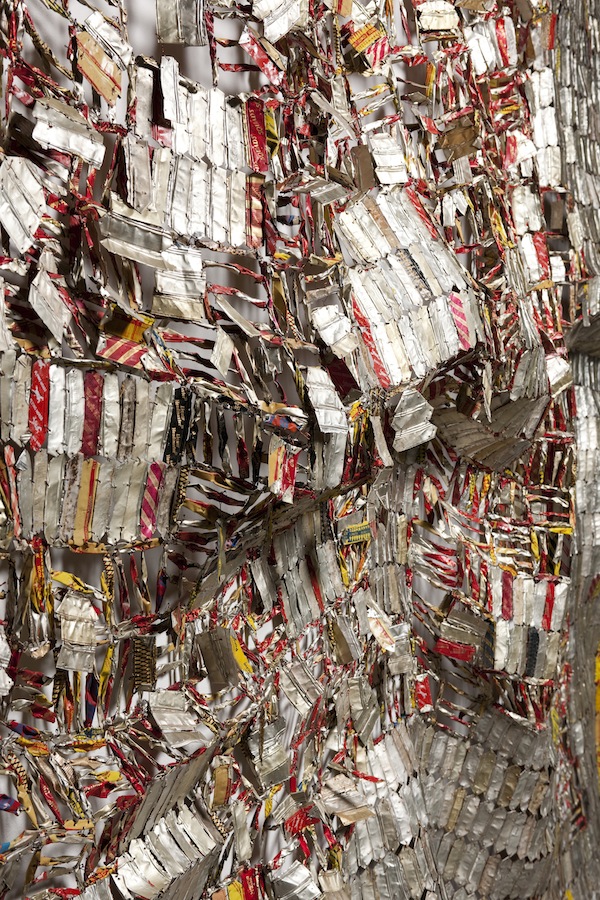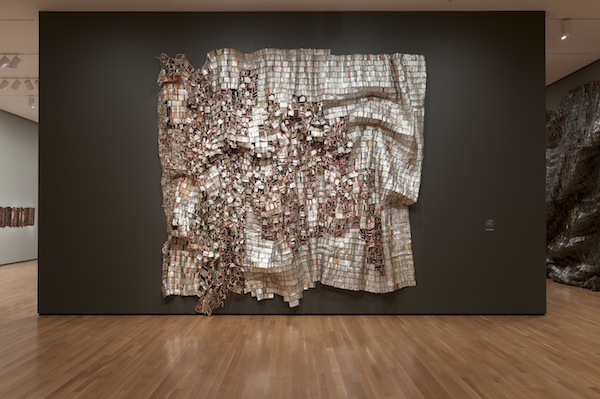
Awaiting El Anatsui: Gravity and Grace: Monumental Works by El Anatsui at the Bass Museum of Art
By Elizabeth Shannon, Bass Museum of Art
This week, El Anatsui will be visiting the Bass Museum of Art to put the finishing touches to his exhibition Gravity and Grace: Monumental Works by El Anatsui, which opens to the public on Friday 11 April.
El Anatsui, Gravity and Grace, 2010, aluminum and copper wire, 174 x 396 inches. Installation at the Akron Art Museum. Courtesy of the artist and Jack Shainman Gallery, New York. Photo by Andrew McAllister. Courtesy of the Akron Art Museum.
Unusually, given that most artists’ work arrives with specific instructions for its display, the Bass team has had a substantial hand in the appearance of most of Anatsui’s pieces. This is because the artist’s most recent work consists of huge sheets made from metal bottle caps and folded aluminum bottle neck wraps, connected in a patchwork fashion. These beautiful, shimmering works are hung from the ceiling or positioned against a wall, and are sculpted and draped by the installers.
Since our exhibition is part of a national touring show, we were lucky enough to benefit from previous venues’ experience. We were encouraged by Joe from the Akron Art Museum (the exhibition’s originating venue), who visited to assist us with the installation, to be brave and impose our own vision upon the works: both a freeing and nerve-wracking proposition, particularly as we wait for the artist to arrive and pronounce judgment!
Long admired and respected in Africa (and increasingly so abroad), the last decade has seen Anatsui feted as one of the world’s top international contemporary artists. Born in Ghana and brought up during the country’s transition from British colonial rule to independence, Anatsui has spent most of his life in Nigeria, where he taught art at the University of Nigeria in Nsukka until his retirement in 2010. The idea of ‘retirement’ might conjure up impressions of someone slowing down, but for Anatsui retirement has meant a chance to focus entirely upon his art, without the responsibility of teaching.

Portrait of El Anatsui. Photo by Andrew McAllister. Courtesy of the Akron Art Museum.
The celebration of Anatsui’s epic artwork is explained by the richness – in a number of senses – of this quiet artist’s practice. Anatsui’s work combines the influence of a Ghanaian Western-style education; the artist’s investigations into traditional African art, particularly that of Ghana and Nigeria; his outward-looking interest in international contemporary art; his travels around the world; and the fruits of teaching new generations of young African artists. As Anatsui has stated, his work is the product of his individual upbringing and experience, but he also intends it to speak more broadly of universal experience, human connections and environments.
Such ‘richness’ is also, paradoxically, often found in the types of materials with which Anatsui chooses to work. Many have a specific connection to place (for instance, beer bottle tops and wrappings, printing plates and milk can lids sourced locally in Nigeria), but these locally sourced materials are also indicative of the impact of mass consumerism across the world. Moreover, the liquor bottle tops have a specific historical resonance, pointing up the role that alcohol has played in the colonization of many areas of the world, including Africa, and its role in the development of the slave trade.

El Anatsui, Ozone Layer (detail), 2010, aluminum and copper wire, 165 3/8 x 212 5/8 inches. Courtesy of the artist and Jack Shainman Gallery, New York. Photo by Kazuo Fukunaga. Courtesy of National Museum of Ethnology, Osaka; The Museum of Modern Art, Kamakura and Hayama; The Museum of Modern Art, Saitama; The Yomiori Shimbun and the Japan Association of Art Museums.
It is also impossible to ignore the sheer visual impact of Anatsui’s works, particularly the metal sheets. The full impression made by Anatsui’s most recent metal artworks is hard to express without experiencing these monumental objects in the flesh. Ozone Layer (2010), which will be on display at the Bass, particularly needs to be experienced in person, since it is ‘animated’ by a series of hidden fans, which cause the surface of the work to ripple and partially attached elements to move, creating a ‘soundtrack’ for the viewer.

El Anatsui, Ozone Layer, 2010, Aluminum and copper wire, 158 x 197 inches, Installation at the Akron Art Museum, Courtesy of the artist and Jack Shainman Gallery, New York. Photo by Andrew McAllister. Courtesy of the Akron Art Museum.
Anatsui’s stunning works have been on the walls of the Bass Museum for just over a week, awaiting the arrival of their author. We continue to sculpt and hone the works, and look forward to hearing the artist’s impressions of our installation (and hopefully receiving a little positive feedback!) We invite you join us to celebrate our 50th anniversary year by experiencing this new exhibition of El Anatsui’s astonishing work for yourself.
Recent Content
-
Artsarticle ·
-
Artsarticle ·
-
Artsarticle ·
